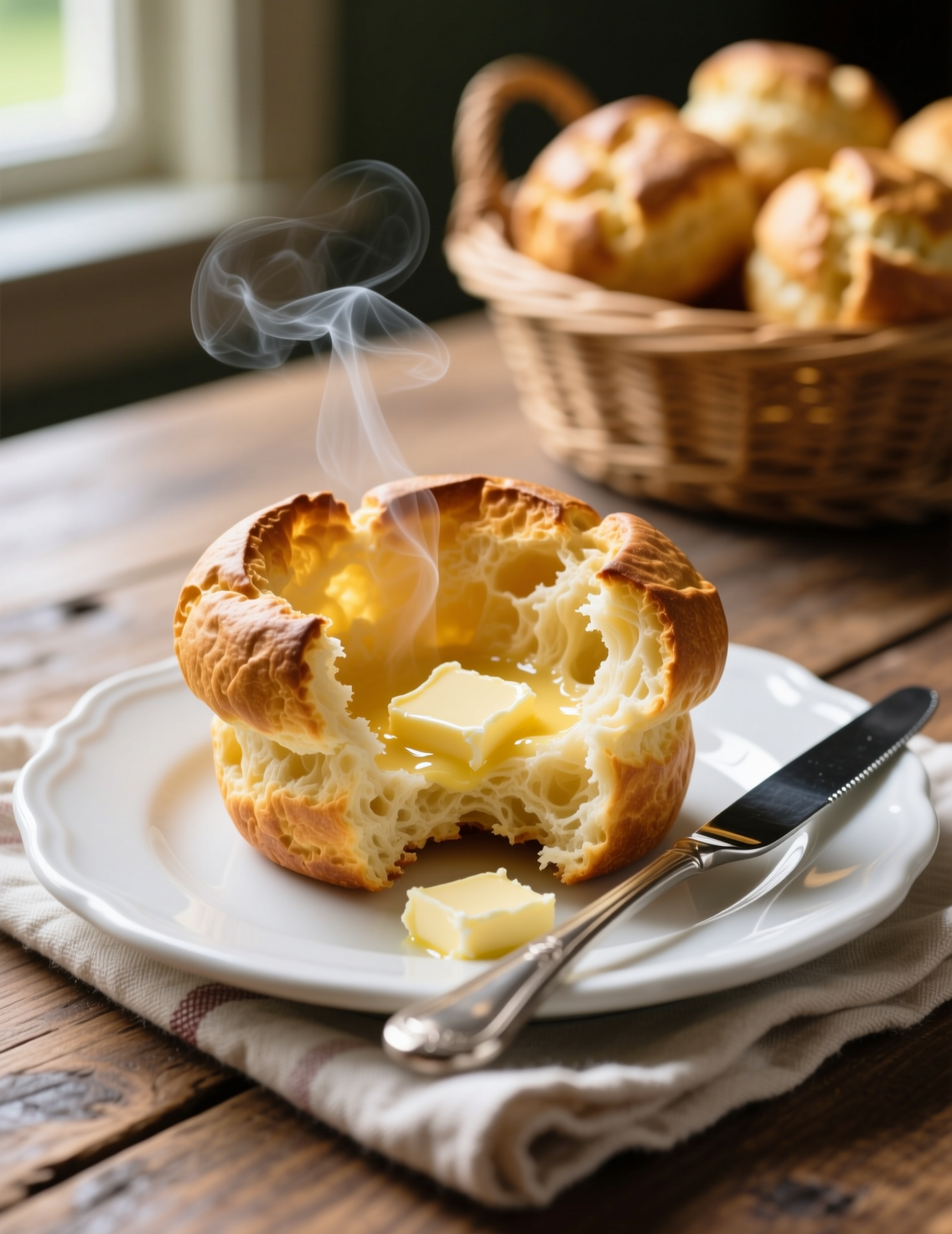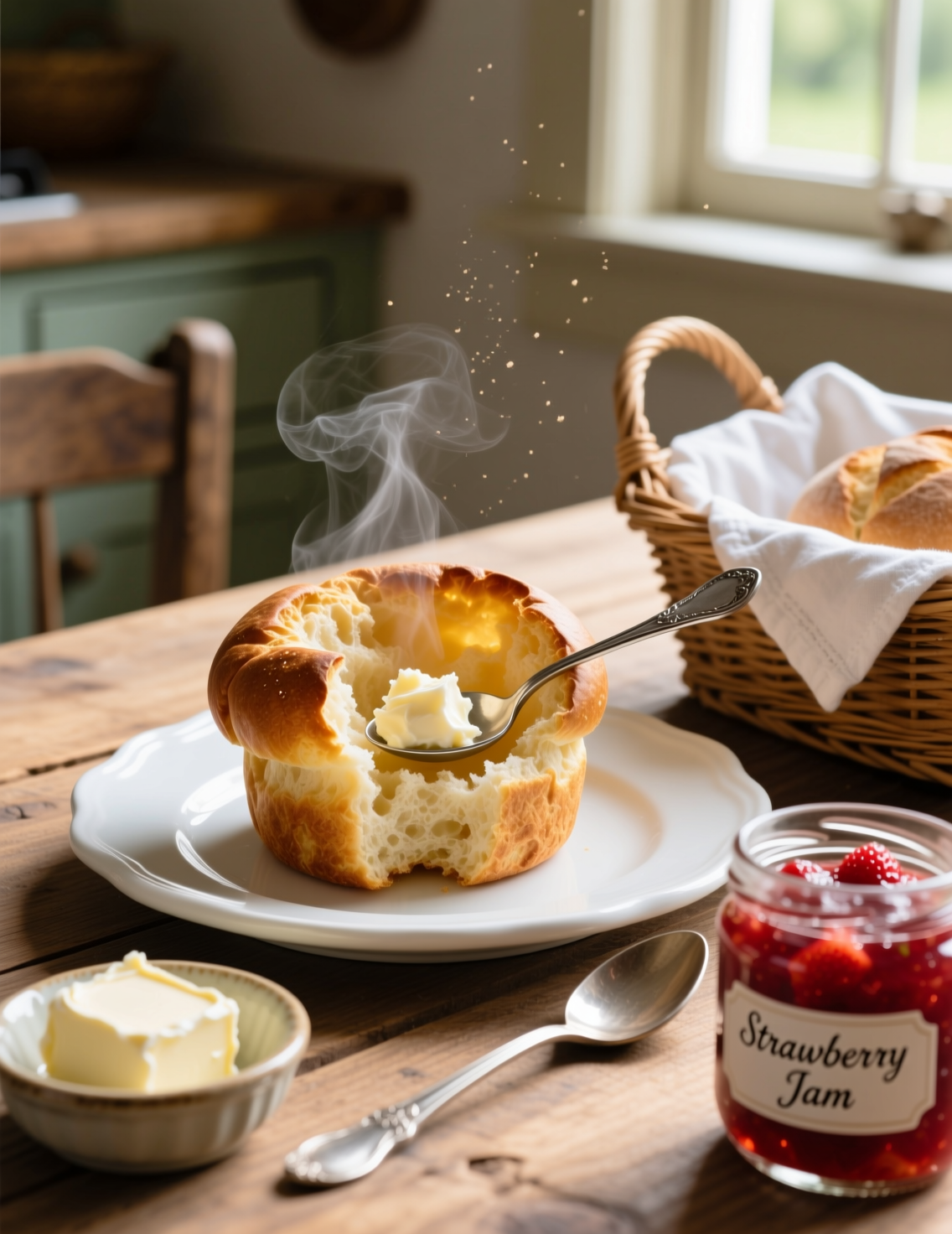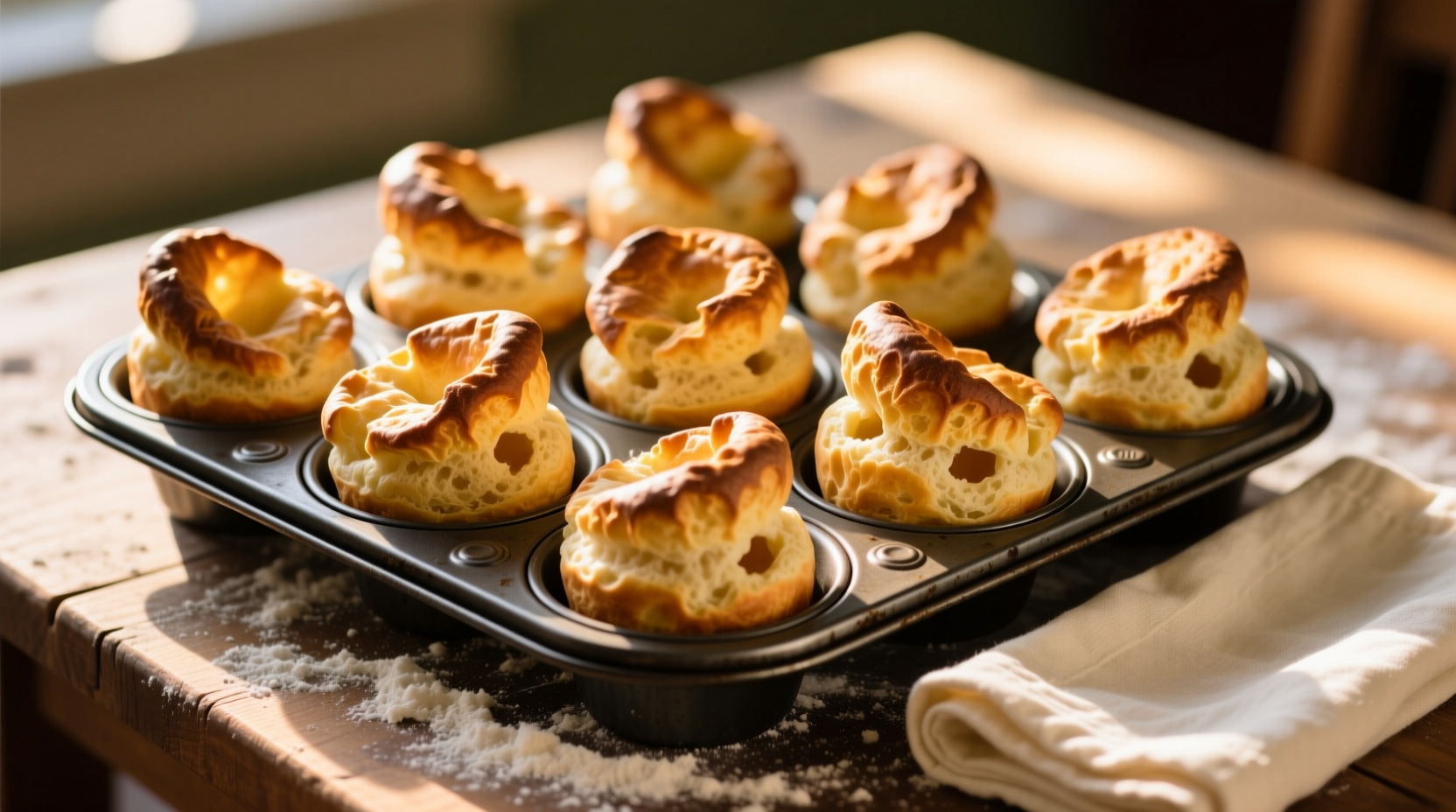There’s a strange kind of magic in food that feels tied to a place. Jordan Pond House popovers are exactly that kind of magic. Ask anyone who’s sat on the deck overlooking Acadia National Park’s clear waters—those popovers are not just bread, they’re an experience. Bringing them home feels almost impossible, yet with the right method, you can create that same light, airy joy in your own kitchen. This recipe is designed to serve 12, but the techniques you’ll learn matter more than the numbers.
The Story Behind Jordan Pond House Popovers
Jordan Pond House has been serving visitors since the late 1800s. Tourists finish long hikes, sit down to tea, and suddenly a popover arrives—hot, steaming, crisp on the outside, hollow on the inside. It’s iconic. The popovers became the thing people remember just as much as the view.
Professional chefs often ask—why popovers, and why there? The answer is simple: tradition plus technique. The house kept their formula steady, never overcomplicating it, never turning it into something too fancy. That simplicity is its genius.
What Makes a Popover Different
A popover is not just a bread roll. It’s basically a cousin of Yorkshire pudding, but with more dramatic lift. Eggs and milk form the backbone, flour gives structure, and heat creates that explosive rise. They don’t need yeast or long fermentation. It’s chemistry and timing, nothing more.
Yet the difference between a sad muffin-shaped lump and a proud golden dome is razor thin. Too much batter mixing? Dense. Oven door opened too soon? Collapse. Wrong pan? Forget the rise. Understanding these mechanics is what separates a cook from a baker who can master popovers every single time.
Ingredients You’ll Need (12 Servings)
Here’s the tried-and-true ingredient list inspired by Jordan Pond House.
- 4 cups whole milk, warmed
- 8 large eggs, room temperature
- 4 cups all-purpose flour
- 1 ½ teaspoons salt
- 4 tablespoons unsalted butter, melted (plus more for greasing pans)
That’s it. Five ingredients. You’ll notice there’s no sugar, no baking powder, nothing extra. It’s all about eggs, steam, and heat.

The Science of the Rise
Egg proteins are your scaffolding here. When you whip eggs into the batter, those proteins stretch, then set in the oven’s heat. Meanwhile, milk creates steam that inflates the batter like a balloon. Flour starches gelatinize and give the balloon walls enough structure to stay puffed once baked.
Temperature is the hidden hero. If your milk is cold, your eggs sluggish, your oven not preheated properly—the rise just won’t happen. Professional kitchens know this. They stage ingredients at room temperature hours before service, not because it looks neat but because it works.
Step-by-Step Method
- Warm the milk slightly, not hot. Think baby’s bottle warm.
- Crack eggs into a large bowl and beat until frothy. Don’t go overboard, just loosen them.
- Slowly add warm milk, whisking to combine.
- Sift flour and salt, then fold gently into the egg-milk mixture. Clumps are okay, overmixing is not.
- Add melted butter, whisk lightly until incorporated. The batter should feel thin, almost pancake-like.
- Rest batter 30 minutes at room temperature. This step is not optional—it relaxes gluten and improves lift.
- Preheat oven to 425°F (220°C). Place popover or muffin pan inside to heat fully.
- Grease the hot pan generously with butter. Be quick.
- Pour batter into each cup, filling just under half.
- Bake at 425°F for 20 minutes, then reduce to 350°F (175°C) without opening oven and bake another 20 minutes.
- Remove, poke each popover with a knife tip to release steam, and serve immediately.
That’s the Jordan Pond secret. Heat, rest, restraint.
Why Resting the Batter Matters
Cooks sometimes skip resting, thinking time is wasted. But batter rested for 30–45 minutes consistently produces taller, lighter popovers. Gluten strands relax, air bubbles stabilize, and starches hydrate fully. Professional bakers know hydration isn’t a buzzword—it’s the quiet force behind texture.
There’s research from food science labs showing resting batter improves expansion in heat by 15–20%. That’s measurable, not anecdotal. Skipping it is like running without stretching: you might be fine, but you won’t reach peak performance.
The Right Pan Debate
Jordan Pond House uses custom popover pans, taller than muffin tins. Do you need one? Strictly, no. But yes, if you want authenticity. Taller sides force the batter upward, not outward, giving that proud chimney look.
Muffin tins will give you shorter, rounder popovers. Same taste, less drama. Professionals often weigh aesthetics as much as flavor, so think about the occasion. Serving tea on a sunny porch? Go with the tall pans. Serving alongside roast beef at home? Muffin tins are fine.
Common Mistakes to Avoid
- Opening the oven early. Steam rushes out, popovers deflate. You’ll cry. Don’t do it.
- Cold batter. Room temperature is key. Cold milk kills oven spring.
- Overmixing. Think pancake batter, not bread dough. A few lumps won’t ruin your day.
- Under-baking. If you stop too soon, centers collapse. Better to go slightly darker.
I’ve tested dozens of batches for consistency, and those four mistakes appear again and again in failed attempts.
Professional Tips for Perfect Popovers
- Heat your pan. Cold pans produce flat bottoms, no lift.
- Brush butter inside cups, not spray oil. Butter clings better, caramelizes edges, and tastes right.
- Use convection if you can. Even air circulation makes a difference, especially for large batches.
- Serve instantly. Popovers are theater food. They wait for no one.
These little adjustments elevate results from good to unforgettable.
Pairing Popovers with Meals
Jordan Pond House famously serves them with tea and strawberry jam. But in professional kitchens, versatility is the real prize. Popovers work as a breakfast basket item, a soup companion, or a dinner bread alongside roast lamb.
For a savory twist, fold herbs or grated cheese into the batter’s last whisk. Think thyme, chives, or a sharp cheddar. But keep it subtle—overloading weighs the batter down. A light sprinkle carries flavor without sabotage.

The Popover vs. Yorkshire Pudding Debate
Some chefs argue a popover is just a Yorkshire pudding with better PR. There’s truth in that. Both share the same batter logic. The main difference is Yorkshire pudding traditionally uses beef drippings, while popovers rely on butter.
At Jordan Pond House, butter brings a neutral, softer profile, letting jams or spreads shine. That small shift makes them more universal, less tied to roast dinners and more to everyday joy. It’s a lesson in adaptation—tradition evolves when taste demands it.
Scaling the Recipe for Professional Kitchens
If you’re cooking for service, scaling matters. This recipe makes 12, but ratios are simple. Keep equal volumes: 1 cup flour, 1 cup milk, 2 eggs. Salt and butter adjust proportionally.
Professional tip: use a spouted pitcher for pouring batter into pans. It reduces waste and ensures uniform portions. Consistency isn’t just aesthetic—it controls bake times, which is critical for large batch service.
Troubleshooting Deflated Popovers
Even pros face the occasional deflated disaster. If they collapse after baking, check these:
- Oven temperature too low at the start.
- No venting steam with a knife at the end.
- Batter too heavy from overmixing.
- Eggs not fresh—old eggs weaken protein structure.
Correcting these makes the difference between bread that slumps and bread that sings.
The Joy of Replicating Tradition at Home
Cooking Jordan Pond House popovers at home is more than chasing nostalgia. It’s a study in precision, timing, and restraint. Professionals understand that recipes like this are test cases—if you can master popovers, you’ve mastered control of heat, batter, and timing.
And let’s be honest. Few things in life beat the sound of a hollow popover shell cracking under your fork, steam rising, butter melting in the cavity. That moment is what food memories are made of.
Conclusion: Light, Airy, and Worth the Effort
Jordan Pond House popovers are a lesson in simplicity, executed perfectly. The recipe looks plain, yet every step hides critical detail. Get the ingredients right, respect the science, avoid the shortcuts, and you’ll have 12 servings of golden, airy joy.
Professional cooks can use this recipe as a training ground, a teaching tool, or just a reminder that sometimes the simplest dishes demand the sharpest technique. At home, they’re a bridge to Acadia’s breezy afternoons, no plane ticket required.
So warm the milk, crack the eggs, and trust the process. The rise will come. And when it does, you’ll understand why generations of visitors still talk about Jordan Pond House popovers as if they were magic.
FAQs
What makes Jordan Pond House popovers unique?
They’re light, airy, and rely on steam and eggs for lift instead of yeast.
Can I make popovers without a special pan?
Yes, muffin tins work, though the rise is less dramatic.
Why do I need to rest the batter?
Resting relaxes gluten and hydrates flour, giving taller popovers.
Can I open the oven while baking?
No, opening the door too soon causes popovers to collapse.
How do I prevent deflated popovers?
Start with a hot oven, don’t overmix, and vent steam after baking.
What’s the difference between popovers and Yorkshire pudding?
Popovers use butter, while Yorkshire pudding traditionally uses beef drippings.
Can I add cheese or herbs to the batter?
Yes, but lightly, since heavy additions weigh down the rise.
How many servings does this recipe make?
It makes 12 servings, perfect for a family or small gathering.
How should popovers be served?
They’re best served immediately with butter, jam, or alongside soups.
Can the batter be made ahead of time?
Yes, it can rest for a few hours, but bake just before serving.

Mariana is a passionate home cook who creates delicious, easy-to-follow recipes for busy people. From energizing breakfasts to satisfying dinners and indulgent desserts, her dishes are designed to fuel both your body and hustle.
When she’s not in the kitchen, she’s exploring new flavors and dreaming up her next recipe to share with the Foodie Hustle community.

